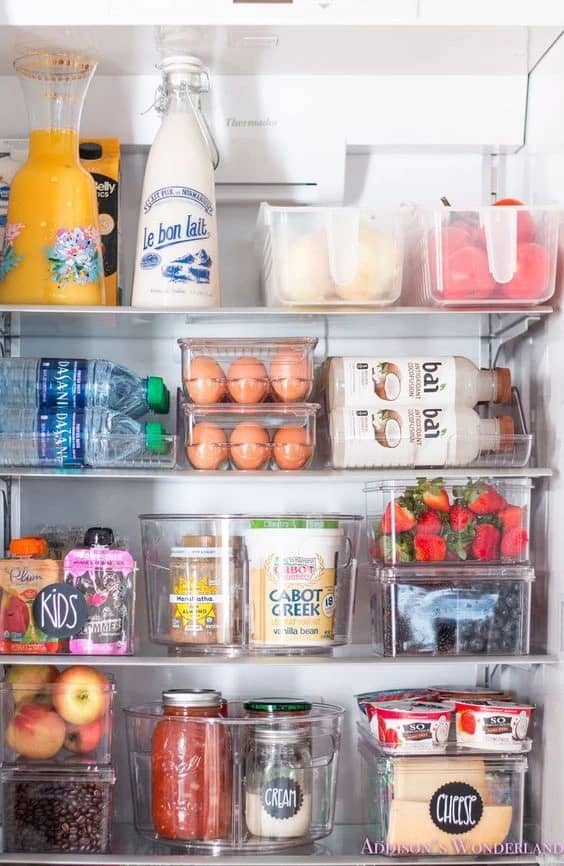The heat is on
It’s that time again and your guests are devilishly hungry so dinner better be ready when they arrive. The problem is you can’t find the garlic cloves for the sausage and vegetable skillet, your signature dish. You’ve scoured your refrigerator and now the only option is to literally take everything out of the fridge.
You start pulling everything out one by one as fast as you can. Finally, you get to the last shelf and sure enough there it is tucked neatly behind the Tupperware filled with last week’s ravioli. The day is saved, but a catastrophe was barely averted.
What can you do to prevent this in the future and be more like a 3 Michelin star chef? It starts by having a neat and organized refrigerator.


What we can learn from professional chefs
Chefs are some of the most creative, organized people. They think up masterpieces and then remake them 100’s of times per night. They are also tasked with not poisoning their customers and must adhere to strict health code regulations.
This means they must have systems for everything. It’s imperative that they know where each item is stored in the refrigerator so they don’t have to go searching for ingredients each time they need more, especially in the heat of the dinner rush. Looking for something in the refrigerator is more time the customer is spent waiting, and customers hate waiting for food.
So they put everything in the same place all the time, then they date it so they know when the expiration is. If the chef is really smart they write the date when the labeled food will expire so there is no extra thinking down the road. Along with that, all their containers neatly stack on top of one another so everything fits in an organized way.
Making our refrigerators, chef-grade refrigerators.
It’s always helpful to section areas off. That way you always know exactly what area to look in when searching for something. Here are some possible areas and suggestions to start.
Areas to section:
Shelves
Drawers
Right Door
Left Door
Freezer top
Freezer bottom
Categories:
Vegetables
Meats
Salad condiments
Sandwich condiments
Cheeses
Snacks
Soups
Leftovers
Breakfast
Lunch
Dinner
Drinks
Ways to store things
In boxes
Special containers/bottles for things like condiments
Add on Items like shelf clip
From here we start to put things together. For instance, maybe we make the top left shelf for leftovers only. For any section, a good rule of thumb is if you get, say, a new leftover and have no room, you must throw away an old leftover.
Then we can start sectioning off the rest of the selves; bottom right drinks, bottom left for extra storage when cooking. The top right can be for eggs and wine. After that, we can fill the drawers. One drawer for vegetables and another for meat. If you have more than 2 then maybe separate green vegetables from colored ones and red meats from white.
With the shelves, it’s nice to use boxes for things that usually come out altogether. This way you can grab everything you need at once without having to go back and forth to the refrigerator five times. For condiments, it’s nice to get special uniform containers to pour everything into. It makes your refrigerator look cleaner and you can get special lids that work perfectly for each type of condiment.
System for labeling
On the front of the fridge keep a list of when certain items go bad. You can find a sheet to print out online. Then attach a magnet to a marker and a roll of masking tape. Then, as you’re putting food away after you have bought it you can rip off a piece of tape and put it on the food or leftover, then write the date on the tape with the marker.
This way you know when it went in, and then when you’re ready to eat something if it’s been a while. You can refer to the list and cross-reference the date to make sure it’s still good to eat.
Let them eat cake
You did it, now your refrigerator is ready to complement your skills. You’ll be working efficiently and will be able to move like a pro in the kitchen. Big dinners with 15+ guests? No problem! Gourmet dinner for the family? Easy.
Your next party comes around, and as you’re making your vegetable skillet you go to look for the garlic cloves and sure enough, they’re exactly where they are supposed to be in the vegetable drawer inside the garlic clove container. No issues this time around, you were able to finish dinner 20 minutes early which gave you some time to relax and enjoy yourself with a martini as your guests slowly start to roll in.
They loved the food, you’re less stressed, and everyone laughs and has a good time.


